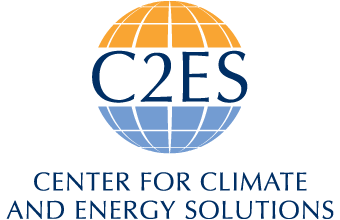Publication
Methane Pyrolysis for Hydrogen Production
This report examines the technology landscape, attributes and advantages, engineering challenges, and commercial status of methane pyrolysis.


Doug Vine is the Director of Energy Analysis at the Center for Climate and Energy Solutions (C2ES). He leads the center’s work on energy decarbonization policies and technology analysis, following trends in global and domestic energy production and utilization and their impact on greenhouse gas emissions. Additionally, he focuses on topical energy issues, including clean energy, electric power, natural gas, and oil market developments.
Mr. Vine has authored numerous reports and briefs on natural gas, preserving existing nuclear power, the North American electricity grid, microgrids, and clean energy standards. Mr. Vine is currently researching pathways toward decarbonizing power and industrial sector emissions, including widespread electrification and the use of low-carbon fuels like hydrogen.
Mr. Vine previously worked at Meridian Energy, New Zealand’s largest electricity generator, where he advised on optimizing the utility’s hydropower portfolio. He also worked for Genscape and Thomson Reuters Point Carbon, where he focused on price forecasting in U.S. regional electricity markets.
Mr. Vine holds an M.B.A from the Victoria University of Wellington. He also holds a Master of Science in systems engineering from Virginia Tech and Bachelor of Science in aerospace engineering from the University of Maryland.
This report examines the technology landscape, attributes and advantages, engineering challenges, and commercial status of methane pyrolysis.
Doug Vine
August 13, 2025
Doug Vine
April 10, 2025
Key Takeaways Nuclear power is one of the few technologies that can economically and technologically meet the thermal needs of industrial process heat applications up to 950 degrees C (1,742 degrees F). Retrofitting facilities (e.g., manufacturing, universities, hospitals) currently utilizing …
Jason Ye, Doug Vine, Brad Townsend, Mahmoud Abouelnaga, Stephanie Gagnon-Rodriguez, Laura Brush, Verena Radulovic, Maddie Lee, Christina Cilento, Nat Keohane, Chris Kardish
December 9, 2021
This brief focuses on the challenge of heat for the industrial sector. Worldwide, heat makes up roughly three-quarters (74 percent) of energy demand for industry and accounts for more than one-fifth of total (all sectors) global energy consumption. Today, most industrial heat production comes …
Most heat energy industry uses today comes from fossil fuel combustion, accounting for about 10 percent of global carbon dioxide emissions. In the United States, the industries using the most heat include petroleum refining, paper, chemicals, cement, and steel. Unless …
The U.S. and Canadian electric power grids are connected by dozens of transmission lines from New England to the Pacific Northwest. The interconnected North American power grid enables two-way trading and benefits both Canada and the United States with enhanced …
Doug Vine, Philip Horowitz
February 25, 2021
This report outlines a comprehensive agenda for decarbonizing the U.S. economy by 2050, with an emphasis on priority actions needed over the coming decade. This agenda was developed in close consultation with leading companies in key sectors through the Center …
Since late 2012, six of the 104 nuclear reactors in the United States have retired. An additional 13 reactor retirements by 2025 have been announced. These early retirements impact the United States’ ability to reduce greenhouse gas emissions and meet …
This is one in a series of briefs prepared as part of C2ES’s Climate Innovation 2050 initiative, which brings together leading companies to examine potential pathways toward substantially decarbonizing the U.S. economy. Other briefs focus on Agriculture & Forestry, Buildings, …
Nuclear power is responsible for around 20 percent of U.S. electricity generation and more than 50 percent of its zero-emission generation. However, these large sources of zero-emission power are being prematurely retired with respect to their operating licenses because of …
C2ES held a Solutions Forum in July 2017 in Carmel, Indiana, focusing on challenges facing nuclear energy and various approaches to preserving the existing fleet of generation. Three panels comprising business, government, power market, think tank, and other experts shared …
More than 190 nations representing more than 95 percent of global greenhouse gas emissions offered “nationally determined contributions” (NDCs) to the Paris Agreement reached in December 2015. The NDC submitted by the Obama administration on behalf of the United States …
Since late 2012, five power companies retired six nuclear reactors in the United States. Across the country, an additional seven reactors are scheduled to be closed by 2025, including two at the Indian Point Energy Center in Buchanan, New York. …
Since late 2012, five power companies retired six nuclear reactors in the United States. Across the country, an additional seven reactors are scheduled to be closed by 2025, including two at the Indian Point Energy Center in Buchanan, New York. …
Cities are at the forefront of the national conversation about climate change. Increasingly, elected officials and city residents are finding ways to deploy more clean energy and reduce their carbon footprints. They are also looking for ways to reduce the …
The U.S. and Canadian electric power grids are connected through 37 major transmission lines from New England to the Pacific Northwest. The interconnected North American power grid provides numerous benefits for Canada and the United States, including enhanced electric reliability, …
Microgrids are not a traditional or typical infrastructure investment for utilities, nor has the existing electric power industry been structured to facilitate development of microgrids by non-utilities. This research paper seeks to identify financial and legal barriers to the development …
More than 180 nations representing more than 95 percent of global greenhouse gas emissions offered “intended nationally determined contributions” (INDCs) to the Paris Agreement reached in December 2015. The United States’ INDC is an economy-wide target to reduce net greenhouse …
Amid the more well-known national-level activity, U.S. states are demonstrating serious climate action. In the past 15 years, 18 states have set greenhouse gas emission reduction targets through legislation or executive orders. Efforts in some of these states have faded …
Maryland’s target to reduce greenhouse gas emissions 25 percent from 2006 levels by 2020 is ambitious and has put it in the company of leading states. As 2020 nears, it is becoming increasingly clear that Maryland will likely achieve this …
Hydropower makes up a sizable share of the U.S. electricity supply. A significant portion of this is imported from Canada, which is linked to the U.S. electricity grid through dozens of connections along the border. Expansion of this resource is …
Nuclear power supplies more than 60 percent of the nation’s zero-carbon electricity. The planned retirement of five nuclear reactors could make it tougher to meet U.S. climate goals. A C2ES brief examines the pressures on the nation’s nuclear fleet and …